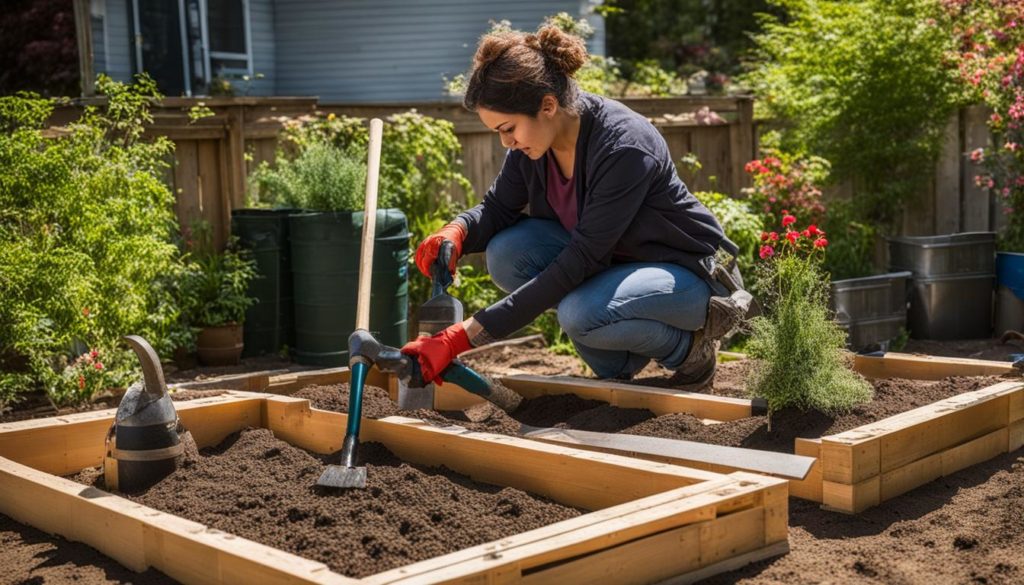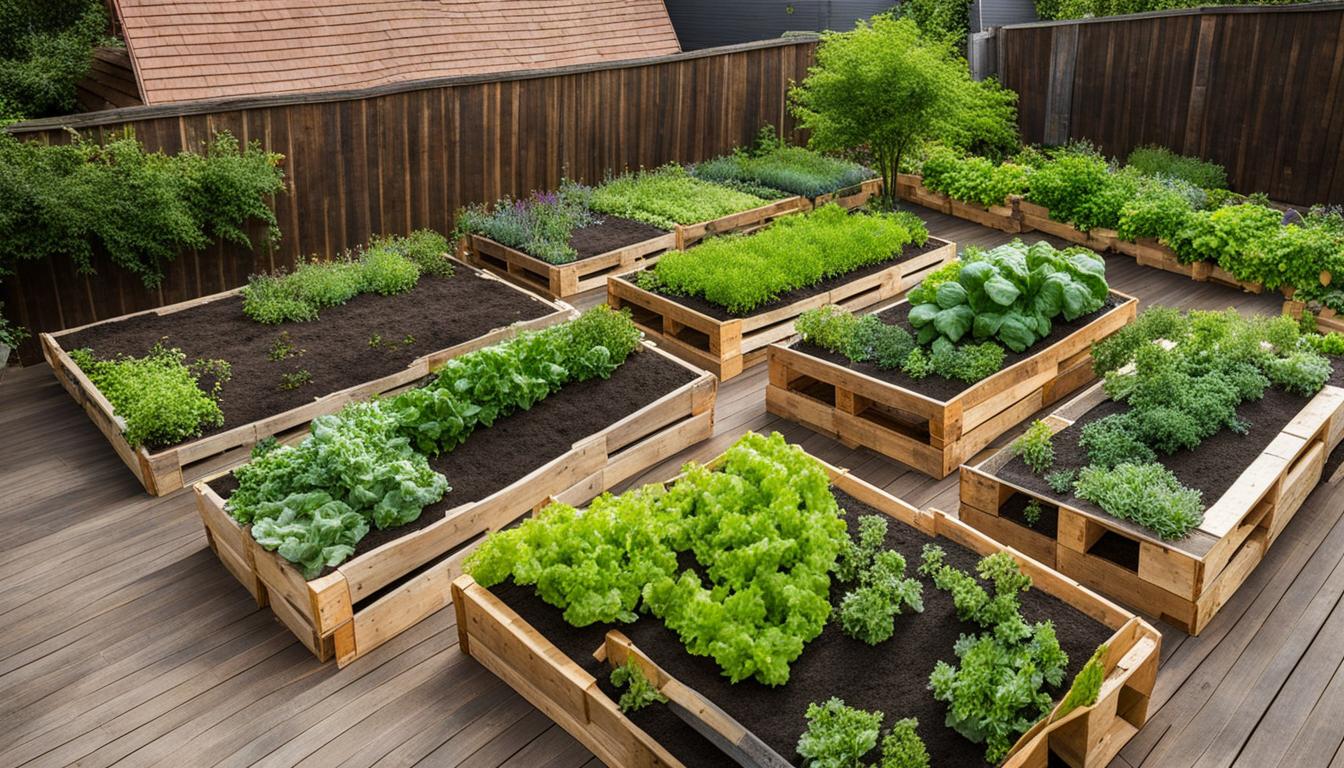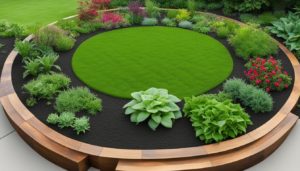Using pallets for raised garden beds is a popular and cost-effective way to enhance the green appeal of your home. It’s a DIY project that allows you to repurpose old pallets and create beautiful and sustainable garden beds. With the right tools and materials, you can easily build your own pallet garden bed and start growing your favorite flowers, herbs, and vegetables. In this article, we will provide you with step-by-step instructions and tips for creating a successful pallet garden bed.
Key Takeaways:
- Using pallets for raised garden beds is a cost-effective and eco-friendly option.
- Choose pallets made of untreated wood or marked with “HT” to ensure safety for your plants.
- Prepare the pallet by cleaning, sanding, and reinforcing it before planting.
- Customize the pallet to create pockets for planting and line it to prevent soil erosion.
- Maintain your pallet garden bed by watering, controlling pests and weeds, and regular pruning.
The Benefits of Using Pallets for Raised Garden Beds
Using pallets for raised garden beds offers numerous advantages that make it a popular choice among garden enthusiasts. Whether you’re a seasoned gardener or a beginner, incorporating pallets into your gardening project can bring a range of benefits to your outdoor space.
Cost-Effective Solution
One of the key advantages of using pallets for raised garden beds is their cost-effectiveness. Pallets can often be obtained for free or at a low cost, making them an affordable option for creating garden structures. By repurposing pallets, you can save money on expensive materials and put those savings towards other aspects of your garden.
Eco-Friendly and Sustainable
Another significant benefit of using pallets for gardening is their sustainability. Many pallets are made from untreated wood or are heat treated (marked with “HT”), which means they are safe for your plants and the environment. By repurposing pallets, you’re giving them a new lease of life and diverting them from landfills, contributing to a more sustainable gardening approach.
Durable and Customizable
Pallets are designed to withstand heavy loads and outdoor conditions, making them a durable choice for garden beds. They can endure various weather conditions without getting damaged, providing you with long-lasting garden structures. Additionally, pallets are highly customizable. You can easily modify them to suit your garden’s needs, whether it’s creating deeper pockets for root vegetables or adding decorative elements.
| Benefits of Using Pallets for Raised Garden Beds |
|---|
| Cost-effective |
| Eco-friendly and sustainable |
| Durable and customizable |
Choosing the Right Pallet for Your Garden Bed
When it comes to using pallets for raised garden beds, selecting the right pallet is crucial for the success of your gardening endeavors. Here are some tips to help you choose the perfect pallet for your garden bed:
1. Look for Untreated or Heat Treated Pallets
It’s essential to choose pallets made of untreated wood or marked with “HT” (heat treated) instead of chemicals. This ensures that you’re using a safe and non-toxic material for your plants. Avoid pallets that have obvious oil spills or signs of rot or mold growth.
2. Source Free or Low-Cost Pallets
You can often find used or old pallets for free at hardware stores, garden centers, or by simply asking around. Just make sure to inspect the pallets carefully before using them for your garden bed. Check for cracks, broken boards, or loose nails that could compromise the structural integrity of the pallet.
3. Ensure Good Condition
Before repurposing a pallet for your garden bed, ensure that it is in good condition. A sturdy and intact pallet will provide a stable foundation for your plants. Avoid pallets that are warped or have missing boards, as they may not hold the soil properly.
By following these pallet selection tips, you can ensure that you choose a safe and suitable pallet for your raised garden bed. Remember, the right pallet will not only enhance the visual appeal of your garden but also provide a sustainable and functional space for your plants to thrive.
Preparing the Pallet for Planting
Before you start planting in your pallet garden bed, it’s crucial to properly prepare the pallet to create an optimal environment for your plants to thrive. Follow these steps to ensure your pallet is ready for planting:
- Clean the pallet: Start by giving the pallet a thorough clean using a stiff brush and soapy water. Remove any dirt, debris, or loose splinters. This will help create a clean and safe space for your plants.
- Sand rough edges: If you notice any rough edges or splinters on the pallet, gently sand them down to create a smooth surface. This will prevent any potential damage to your plants or injuries to your hands during planting.
- Remove protruding nails: Carefully inspect the pallet for any protruding nails. Use a hammer or pry bar to remove them, ensuring that there are no sharp objects that could harm your plants.
- Reinforce loose joints: Check for any loose joints or wobbly boards on the pallet. If needed, use screws or nails to reinforce these areas and provide stability to the structure.
- Allow chemical-treated pallets to weather: If your pallet has been treated with chemicals, it’s important to allow it to weather before planting. This can be done by leaving the pallet outdoors in a well-ventilated area for a few weeks.
- Clean chemical-treated pallets: If you prefer not to wait for the pallet to weather naturally, you can clean it using a water-and-borax or water/bleach mixture. This will help remove any potentially harmful chemicals and make the pallet safe for planting.
By following these steps, you can ensure that your pallet is properly prepped for gardening and create an ideal environment for your plants to thrive.
Building and Planting Your Pallet Garden Bed
Now that you have prepared your pallet, it’s time to start building and planting your pallet garden bed. This process involves reconfiguring the pallet to create suitable pockets for planting and ensuring that your plants have the necessary soil and support to thrive.
Building the Pallet Garden Bed
To create deeper pockets for your plants, start by adding extra slats of wood to the inside of the pallet. These additional slats will provide more space for your plants’ roots to grow. You can secure the slats with screws or nails for added stability.
In addition to adding extra slats, consider adding bottom pieces to hold the soil in place. This will prevent the soil from spilling out when you water the garden bed or during heavy rain. Secure the bottom pieces to the bottom of the pallet using screws or nails.
Once you have added the extra slats and bottom pieces, your pallet garden bed is ready for planting.
Planting in the Pallet Garden Bed
Before planting, line the back, bottom, and sides of the pallet with landscape fabric or wire mesh. This will help prevent the soil from falling out while still allowing for proper drainage.
Fill the pallet with high-quality potting soil, making sure to distribute it evenly among the pockets. Leave some room at the top of each pocket to accommodate the plants that you will be planting.
When choosing plants for your pallet garden bed, opt for shallow-rooted varieties such as herbs, lettuce, strawberries, or succulents. These plants are well-suited for the limited soil depth of a pallet garden bed and will thrive in this environment.

With your plants selected, carefully transplant them into the pallet garden bed, making sure to give each plant enough space to grow. Once planted, water the garden bed thoroughly to ensure that the soil is evenly moist.
Now that you have built and planted your pallet garden bed, it’s time to sit back and watch your plants grow. Remember to water and care for your plants regularly, and enjoy the beauty and productivity of your pallet garden bed.
Caring for Your Pallet Garden Bed
Proper maintenance is key to ensuring the long-term health and productivity of your pallet garden bed. By following these maintenance tips, you can keep your garden thriving and beautiful throughout the growing season.
Regular Watering
Water is essential for the growth of your plants, so it’s important to water your pallet garden bed regularly. Make sure to water both the top and bottom of the pallet to ensure that the soil is evenly moist. Monitor the moisture levels by inserting your finger into the soil. If it feels dry, it’s time to water. Adjust your watering schedule as needed, depending on the weather conditions and the needs of your plants.
Pest and Weed Control
Keep an eye out for pests and weeds that can disrupt the health of your plants. Inspect your plants regularly and take necessary measures to control pests such as aphids, slugs, or snails. You can use organic pest control methods or companion planting to deter pests naturally. Additionally, remove any weeds that may compete with your plants for nutrients and resources.
Fertilization and Pruning
Provide your plants with the nutrients they need by fertilizing them as needed. Use organic fertilizers or compost to nourish the soil and promote healthy growth. Pruning is also important for maintaining the shape and health of your plants. Regularly remove dead or damaged leaves and stems to encourage new growth and prevent the spread of diseases.
Monitor Soil Quality
Regularly monitor the quality of the soil in your pallet garden bed. Over time, the soil may become compacted or depleted of nutrients. To improve the soil quality, you can add organic matter such as compost, aged manure, or worm castings. This will help replenish the nutrients and enhance the overall fertility of the soil.
| Task | Frequency |
|---|---|
| Watering | Regularly, when soil feels dry |
| Pest and weed control | Regularly, inspect plants and take necessary measures |
| Fertilization | As needed, following product instructions |
| Pruning | Regularly, remove dead or damaged leaves and stems |
| Soil monitoring and improvement | Regularly, add organic matter to improve soil quality |
Inspiring Ideas for Pallet Garden Beds
When it comes to creating pallet garden beds, the possibilities are endless. With a little creativity and ingenuity, you can turn a simple pallet into a stunning and unique garden structure. Here are some inspiring ideas to get you started:
1. Vertical Pallet Garden
Transform your pallet into a vertical garden by attaching small pots or planters to the slats. This is a great option for small spaces, as it allows you to maximize your growing area vertically. You can plant a variety of herbs, flowers, or succulents to create a lush and vibrant display.
2. Herb Spiral
Create a spiral-shaped pallet garden bed by stacking multiple pallets on top of each other and filling them with soil. Plant different herbs in each level, starting with those that require more sun on the top and gradually moving to shade-loving herbs as you descend. This not only looks visually appealing but also optimizes the use of space and sunlight.
3. Pallet Fence Planter
If you have a fence in your garden, why not turn it into a vertical garden using pallets? Attach pallets horizontally to the fence and secure them in place. Then, add small planter boxes or pots to the slats and fill them with your favorite flowers or trailing vines. This adds a pop of color and greenery to your fence while maximizing your growing space.
4. Pallet Raised Bed with Trellis
Combine the functionality of a raised bed with the support of a trellis by creating a pallet garden bed with a built-in trellis. Attach a pallet vertically to the back of your raised bed and secure it firmly. This provides a structure for climbing plants such as tomatoes, cucumbers, or beans to grow vertically, saving space and creating a visually striking display.
Remember, these are just a few ideas to spark your creativity. Feel free to experiment and customize your pallet garden bed to suit your personal taste and style. Whether you’re going for a rustic look or a modern design, the key is to have fun and enjoy the process of transforming a simple pallet into a beautiful garden masterpiece.
Conclusion
Using pallets for raised garden beds offers a cost-effective and sustainable way to enhance the beauty of your backyard. By repurposing old pallets, you can create unique and customizable garden structures that will bring life to your outdoor space.
With the right preparation and care, your pallet garden bed can flourish, providing you with a plentiful harvest of fresh herbs, flowers, and vegetables. By following the step-by-step instructions provided in this article, you can easily build your own pallet garden bed and enjoy the rewards of a vibrant and productive garden.
So, why not give it a try? Unlock the potential of using pallets for your gardening endeavors and experience the benefits of this eco-friendly and creative DIY project. Start your pallet garden bed today and transform your backyard into a green oasis!
FAQ
What are the benefits of using pallets for raised garden beds?
Using pallets for raised garden beds is a cost-effective and eco-friendly option. It allows you to repurpose materials and create durable garden structures. Pallets also offer easy mobility and customization options.
How do I choose the right pallet for my garden bed?
When selecting a pallet, make sure it is made of untreated wood or marked with “HT” (heat treated) instead of chemicals. Avoid pallets with oil spills or signs of rot or mold. Ensure the pallet is in good condition with no cracks or broken boards.
How do I prepare the pallet for planting?
Start by cleaning the pallet with a stiff brush and soapy water. Sand rough edges or splinters. Remove protruding nails and reinforce loose joints with screws. If the pallet has been treated with chemicals, allow it to weather or clean it with a water-and-borax or water/bleach mixture.
How do I build and plant my pallet garden bed?
Reconfigure the pallet by adding extra slats and bottom pieces for deeper pockets and soil retention. Line the back, bottom, and sides with landscape fabric or wire mesh. Fill the pallet with high-quality potting soil and choose shallow-rooted plants for best results.
How do I care for my pallet garden bed?
Water your plants regularly, checking moisture levels and adjusting watering schedule accordingly. Watch out for pests and weeds and take necessary measures to control them. Fertilize as needed and prune for healthy growth.
What are some inspiring ideas for pallet garden beds?
You can paint or stain the pallet to match your garden decor, use chalkboard paint for labeling, and add decorative trim pieces. Consider repurposing additional materials like old chairs or vintage milk cans for unique garden structures.


